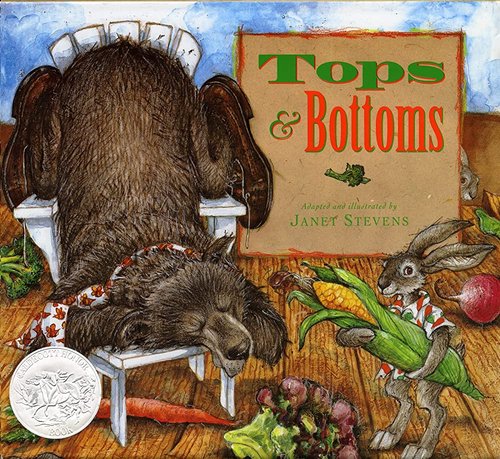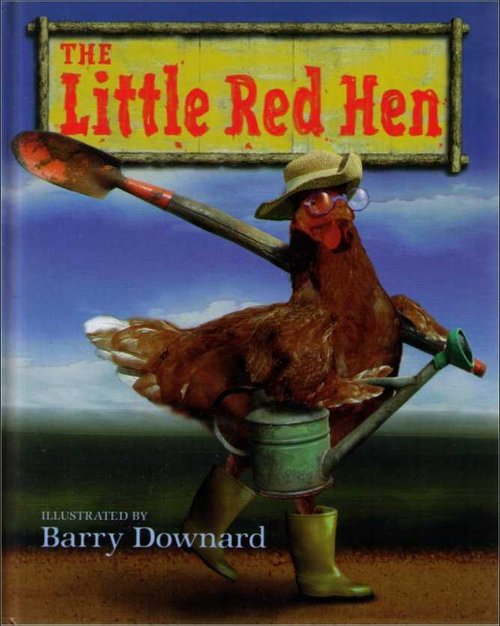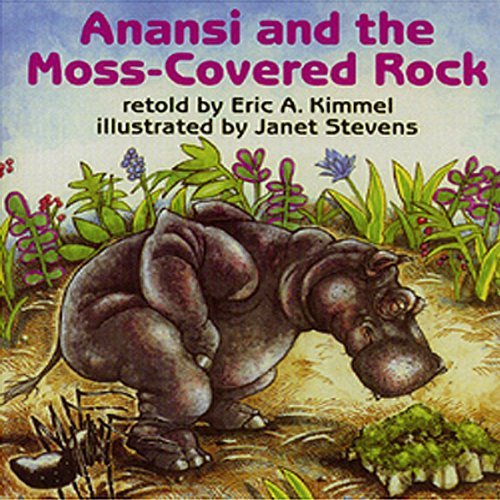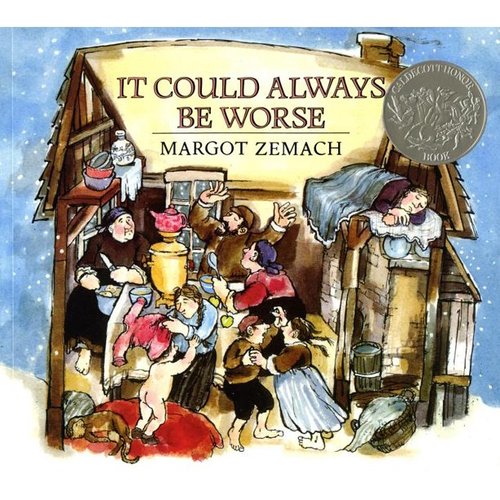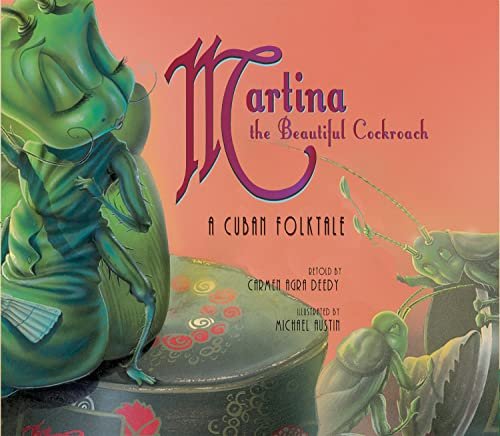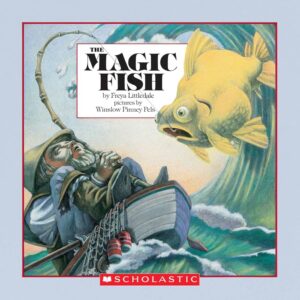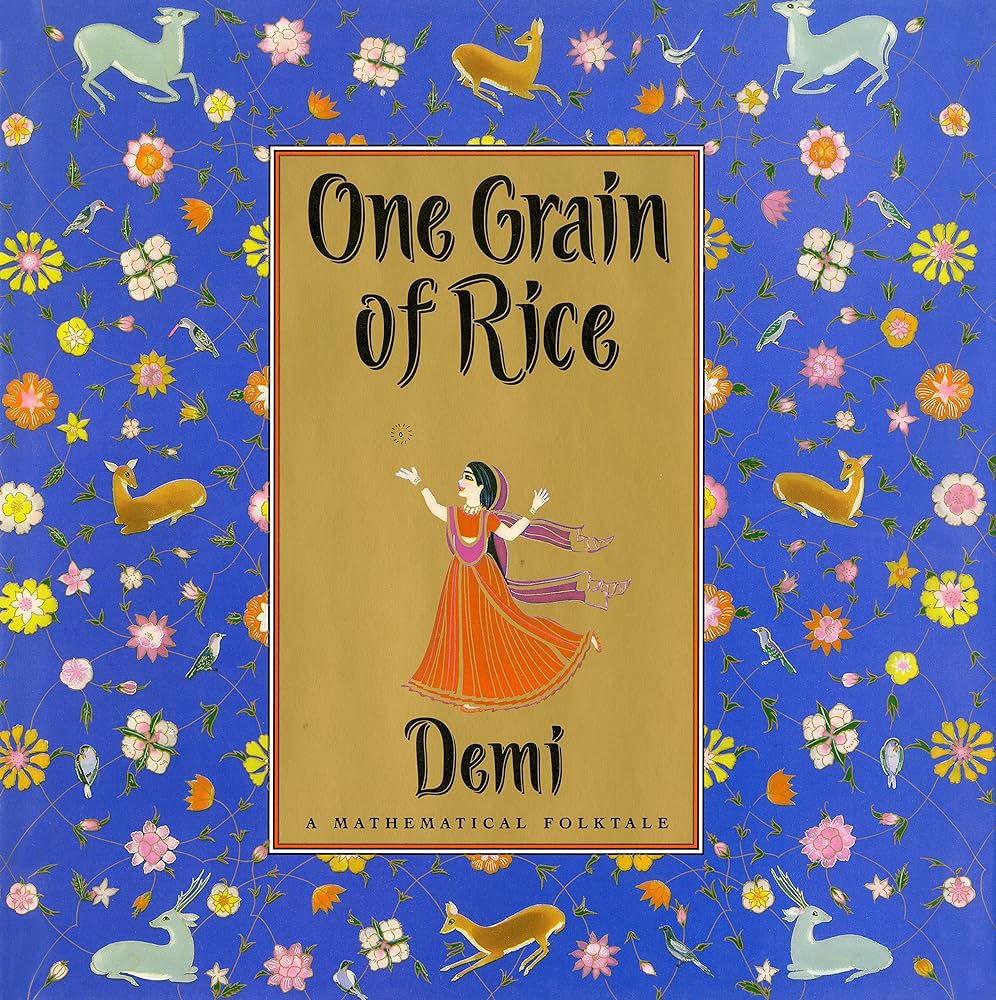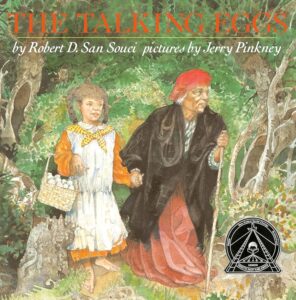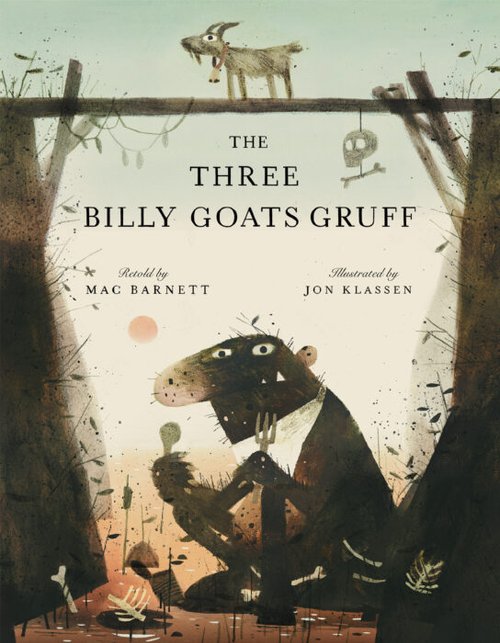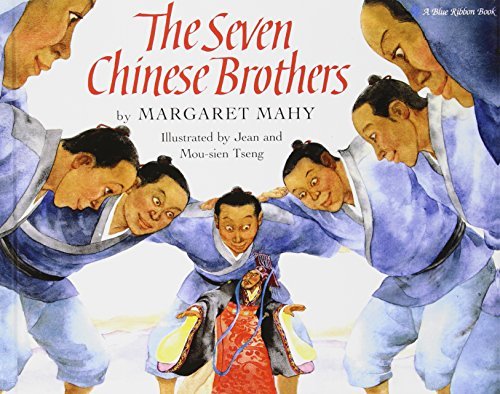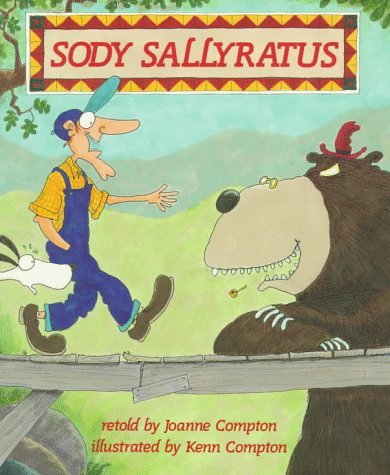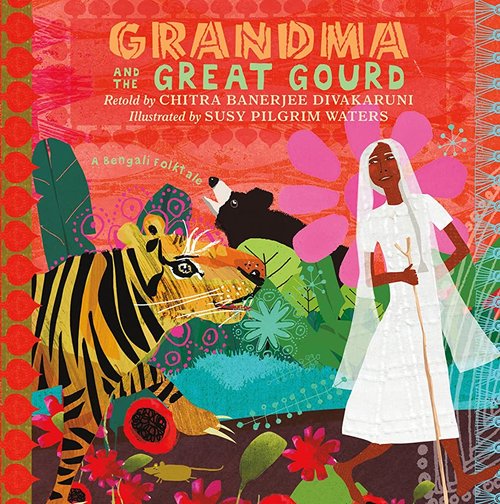Teaching Story Elements with my All-Time Favorite Folktales!
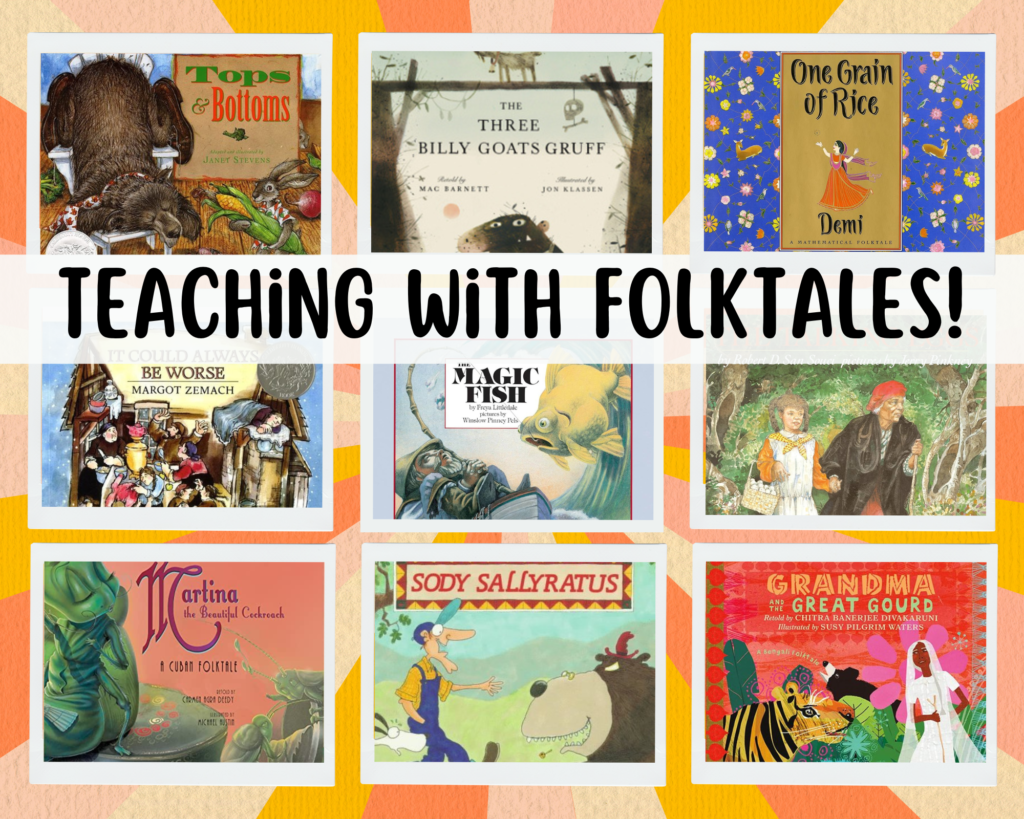
Teaching story elements? Then folktale picture books are a gift sent from above.
I love folktales.
I love listening to folktales.
I love reading folktales.
And I love retelling folktales and putting my own spin on them.
I don’t think I’m alone in professing my love to this superb subgenre of storytelling. But what is it about folktales that makes them so delightful to read aloud and so enchanting to listen to?
The mere thought of a folktale conjures visions of skillful storytelling in action. Presumably around a fire or in a thatched hut or on a grandparent’s knee. But as they are passed down from generation to generation, they become primed and perfected for listening. This makes them easy and fun to remember–and just as enjoyable to retell.
And when students are completely absorbed in a story (researchers call this phenomenon narrative transport), barriers to learning are lowered and cognitive engagement is enhanced. In other words, it’s the perfect time for teachers to hit ‘em with a one-two punch of learning the reading standards while relishing a well-crafted narrative.
I think we can generally agree that sharing folktales are a pleasant way to while the time. However, there are some pretty darn noteworthy benefits to sharing folktales with children:
I mean, what’s not to love?!
Illustrious storyteller Patricia Polacco remembers listening to the elders in her family tell how things were. Now she is the one who passes down family history.
Interactive Read-Aloud Lesson Ideas:
‘Round the Horn Retelling: After reading a folktale, have students stand or sit in a large circle. Designate a story starter. The story starter says one sentence to start the story. (“Once upon a time there was a little red hen who lived on a farm.”) The student to the right of the story starter states the next plot event that occurred– but only in ONE sentence. Then the next student states a sentence, then the next, and so on until the entire story has been retold one sentence at a time. You can have students pass the book, a ball, or another trinket as they go around the circle.
Story Element Toss: A super quick and easy way to informally assess students’ recall of story elements. After reading, toss a Koosh or squishy ball (I use this one) to students as they tick off the story elements. Who are the characters? Toss to a student. What is the setting? Toss to a student. What is the conflict? Toss to another student. What is the first plot event that occurs? Toss to a different student. And so on and so forth.
You can also turn this into a game of Story Element Silent Speedball, only allowing the person with the ball to speak. Anyone who drops the ball, makes a bad throw, or speaks out of turn is OUT. The last student standing is declared the winner. If you have a lot of students, you may want to incorporate more than one story.
Hand Gestures: I have a special hand gesture for each story element that students recite with me, and they LOVE applying them to the stories we read! In fact, we revisit these hand gestures all year long! Shoot me an email if you want to see the video for mine, or you can totally make up your own!
Rainbow Retelling Beads: Use pipe cleaners and pony beads (I got both at Walmart for about $5) to create retelling bracelets! I created them all ahead of time and then trimmed the pipe cleaners to make them shorter for little wrists. Students will slide one bead across at a time as they retell the story to a partner. You can grab my Rainbow Retelling anchor chart to place under your document camera in the Freebies Vault! *Since our K-1 students use the term moral and 2-5 students use theme, I made two versions.
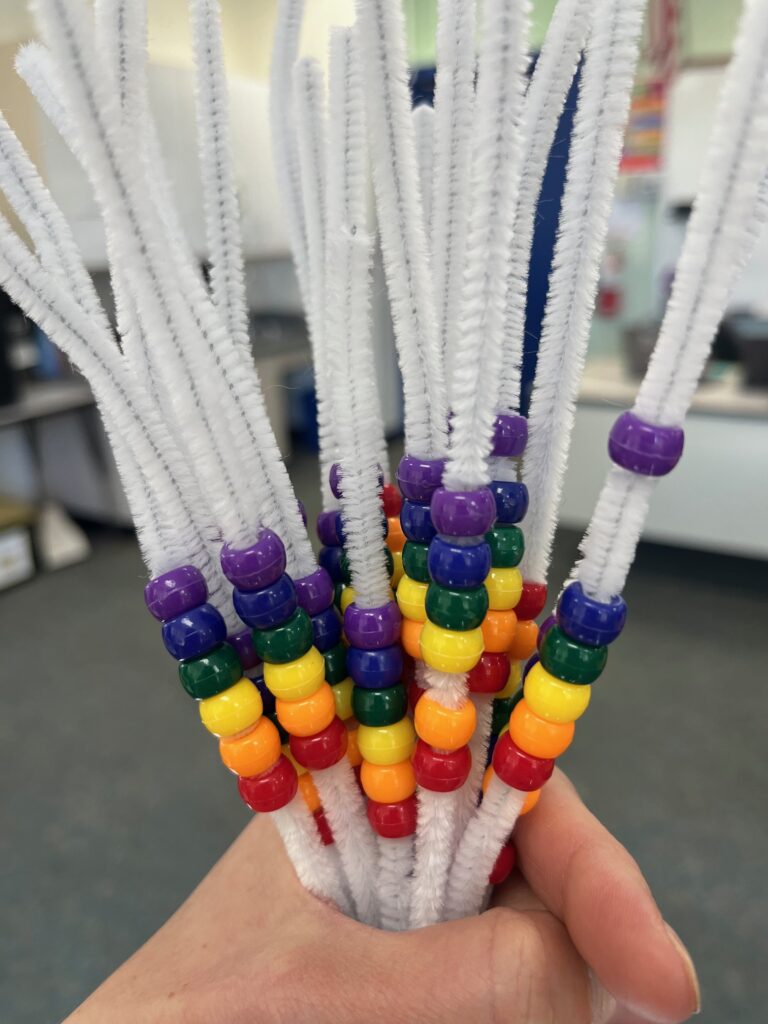
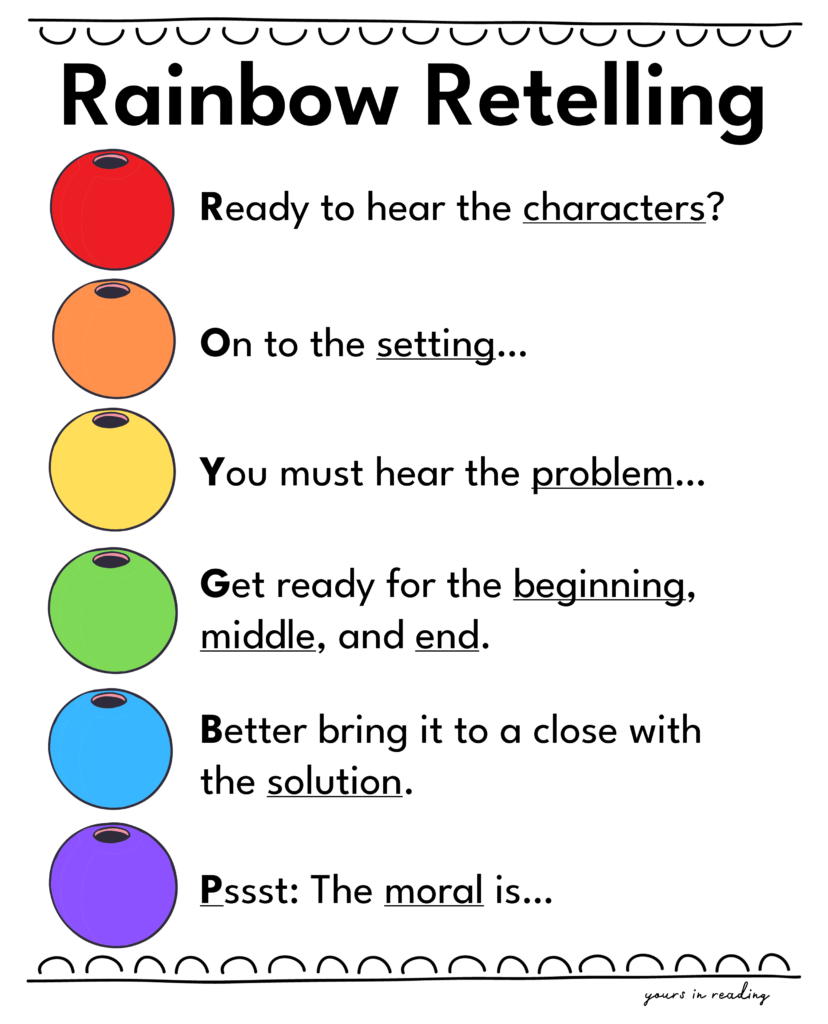
Human Plot Mountain (*grades 3+): Ooh, this one will make memories. Type up story elements (Exposition, Plot Event #1, Plot Event #2, Plot Event #3, Plot Event #4, Climax, Resolution) and print each one out on its own separate paper. Clear a space for your Human Plot Mountain. Distribute signs to students (you can pair up students for a larger class).
Ask for the Exposition sign to come up first and state the characters, setting, conflict. (If working in pairs they can confer before answering.) The student then takes a seat on the floor at the base of the imaginary Plot Mountain. Whomever is holding the Plot Event #1 sign states the first plot event and then kneels next to the first student. The student with the Plot Event #2 sign states the second plot event and squats next to the second student. Add more plot events as needed with the students getting closer to a standing position. The student with the Climax sign will state the climax and then stand up nice and tall. The rest of the plot events (the falling action) will mimic the rising action (squat, kneel, etc.). Finally you arrive at the base of the mountain with the student holding the Resolution sign, who sits on the floor.
All-time favorite folktales to use as mentor text (or to read just for fun!)
Below you will find a list of my absolute favorite folktales to share with students. They are perfect for teaching story elements while cultivating a deep appreciation for the art of storytelling, and each one of them can be applied to the above lessons.
*Disclaimer: This post contains affiliate links. Purchases made through the links provide me with a small commission at no cost to you!
What makes Tops and Bottoms unique is the way you open the book and turn the pages—not side to side like a traditional book, but top to bottom! Conniving Hare tricks lazy Bear out of his crops by telling him that he’ll do all the work and they can split the profits. When Bear asks for the tops of the crops, Hare plants root vegetables, leaving Bear with a useless pile of leaves. Angrily, Bear orders the bottoms of the next share of crops, but clever Hare plants a variety of lettuces, again leaving Bear empty handed. Bear demands tops AND bottoms of the final batch of crops and students will have a grand ‘ole time guessing what that trickster Hare will plant to leave Bear with a big pile of nothing.
The Little Red Hen is the perfect text to use for an introduction to folktales and story elements! It’s easy to follow, which makes it easy for students to retell! Any version will work, but Barry Downard’s photo collages take this classic tale and turn it into something else! Hardworking Hen can’t seem to recruit any help in planting her seeds, harvesting her wheat, taking it to the mill, and turning it into bread. She turns to her friends (the duck, the pig, and the cat) but they are much too busy playing pool, sunbathing, and watching “Harry Trotter” on TV to lend a helping hand. But of course no one is too busy to help taste the homemade bread warm from the oven!
Far and away my favorite of the Anansi tales, Anansi and the Moss-Covered Rock is SO MUCH FUN to read aloud. Trickster Anansi comes across a strange moss-covered rock in the forest and quickly realizes that it is a magical rock, which he promptly uses to trick the other animals out of their tasty food supplies. However, Little Bush Deer is hiding in the forest (look for her face peeping behind the bushes on each page) and as she watches Anansi exploit all the other animals, she decides to give him a taste of his own medicine. Make sure you give students a chance to predict what Little Bush Deer’s plan entails before reading the ending!
In this hilarious Yiddish folktale, a poor man lives with his wife, his mother, and his six children in a tiny one-room hut. They are crowded, miserable, and constantly arguing. When the poor man can’t stand it anymore, he seeks help from the Rabbi, who gives him some unexpected advice. As the man follows the Rabbi’s counsel, life goes from bad to much worse and the illustrations get more and more ridiculous with every turn of the page. Finally, the Rabbi provides the poor man with advice that actually makes sense, and he soon realizes that living with his large family in their little tiny hut isn’t quite so bad after all. *Be sure to follow up with The Incredible Shrinking Lunchroom! They LOVE discussing which story elements changed and which stayed the same!
This amusing Cuban folktale is always a hit to read aloud! Before Martina embarks on her search for a worthy husband, her Abuela gives her a shocking piece of advice: to spill coffee on each of her potential suitor’s shoes. The Coffee Test will allow Martina to witness their true colors, and according to Abuela, it never fails. Just reading the line, Martina Josephina Catalina Cucaracha, Beautiful Muchacha out loud makes for a delightful day indeed.
Carmen Agra Deedy’s TEDx Talk, Imagine a World Without Stories, is definitely worth a listen.
Chances are your students have heard a version of The Magic Fish, but it’s worth reading again and again because there is so much magic in its simplicity! The poor fisherman must take his wife’s wishes to the magic fish and ask for them to be granted. After she wishes for a pretty house, a castle, and to be queen of the land the fish finally puts his foot down. “No. You have asked for too much. Now you must go back to the hut.” I love this line so much that I use it whenever my kids ask for too much. It’s a total bargain on Amazon so be sure to snag a copy for your library!
Folktales can include math?! Why, yes they can! Masterful storyteller Demi sets this tale in India, where a selfish raja collects nearly all of the people’s rice for himself. When famine strikes, the raja refuses to share the rice and the people go hungry. A wise girl named Rani performs an honest act and when the raja offers a reward for her honesty she devises a clever plan: she asks for one single grain of rice– and for the amount to be doubled each day for thirty days. At first the raja is underwhelmed by her request, but as the days go by and the amount of rice begins to multiply tremendously, the raja realizes his error and learns a lesson about what it means to be wise and fair. *I love to use Demi’s The Empty Pot to teach the theme of a story and a lesson on integrity.
The Talking Eggs has everything you could possibly want in a folktale: a little bit of magic, a touch of whimsy, good vs. evil, and a plot that sucks you in and spits you out a better person for reading it. This Cinderella-like Creole folktale features kind, patient, and compassionate Blanche and her selfish, greedy, and sneaky mother and sister. One day Blanche bestows kindness to a curious old woman in the forest. She is rewarded with magical eggs that transform into jewels and finery. Upon seeing Blanche’s riches, her jealous mother orders her sister, Rose, to find the old woman and bring back her own bag of riches. Cruel Rose torments the old woman and (surprise, surprise) does not come home with riches but with a fitting consequence for her actions. *Just a heads-up that there is a scene where the old woman takes off her head and places it on her lap, but it’s all part of the magic and mystique and most students don’t even flinch.
Foolish Harvey is tired of being poor. He sets forth to ask the wise and great king how he can become rich. Along the way he meets a hungry wolf, a lonely and beautiful pig, and a thirsty tree. The king grants Harvey the gift of good luck, and if he is deserving of it, he will find all the riches he ever needs. “Keep your eyes and ears open and use your head. They will show you the way,” he advises. Well, Harvey’s not called foolish for nothing. On his hasty return home he fails to see all of the riches staring right at him and meets a unfortunate fate (which is inferred) at the hands of the hungry wolf. *Recommended for grades 3+.
Any version of the classic tale will do, but I’m particularly fond of Mac Barnett and Jon Klassen’s hilarious retelling. There’s just something about Barnett’s word choice and Klassen’s illustrations that give me the crazy lady giggles. Like many of their other books, The Three Billy Goats Gruff gets funnier each time you read it (how?!), and the poetic troll is reminiscent of Shel Silverstein and Roald Dahl. If you don’t have a copy, their narration on YouTube is excellent and worth showing students.
The Seven Chinese Brothers is a childhood favorite that I love retelling to my students. Each of the seven brothers have a unique power which are used to outwit the evil emperor. The illustrations, the repetition, the use of figurative language, the incorporation of Chinese culture and history, and the strong message about the power of family all make this a classic to continue handing down among generations.
Note: You may want to skip this one if you have sensitive listeners. The emperor tries to behead, drown, and set the brothers on fire, among other things. My six-year-old couldn’t get enough, but you know your audience. The Seven Chinese Sisters is a tamer, less violent alternative.
Ma wants to make some biscuits for her son Jack’s return home but, by golly, she is all out of sody sallyratus (baking soda). She dispatches brother Tom to the store for more sody sallyratus but he never returns. Brother Will is sent to find Tom and when he fails to return Ma herself sets out to uncover the whereabouts of her missing sons. Left by his lonesome, brother Jack investigates and runs into a hungry bear, thus saving his family while plotting his own escape. Similar in story structure to The Three Billy Goats Gruff, all ages will relish in retelling this fun and repetitive Appalachian folktale. *Make sure you chant, “Sody, sody sallyratus” before each character sets off.
“What’s life without a little adventure?” Grandma says as she packs up to head through the jungle to visit her daughter. Along the way she meets a slew of hungry animals, anxious to make Grandma their next meal. But clever Grandma encourages them to wait until her return home when she will be much plumper and tastier. When her visit is over and she is surely jungle animal bait, Grandma and her daughter come up with a plan: to hide her in a giant gourd and roll it back home through a path. Will this be an effective plan? Students LOVE to predict what happens. This Bengali folktale features dazzling illustrations, terrific examples of onomatopoeia and simile, and a story structure that is comfortingly familiar yet fun and unique.
There you have it: my all-time favorite folktales!
They are perfect for teaching story elements, but also just as wonderful to read for the sake of sharing a story.
What are your favorite folktales to read-aloud?? I’m ready to add some more to my collection!
yours in reading,
rawley
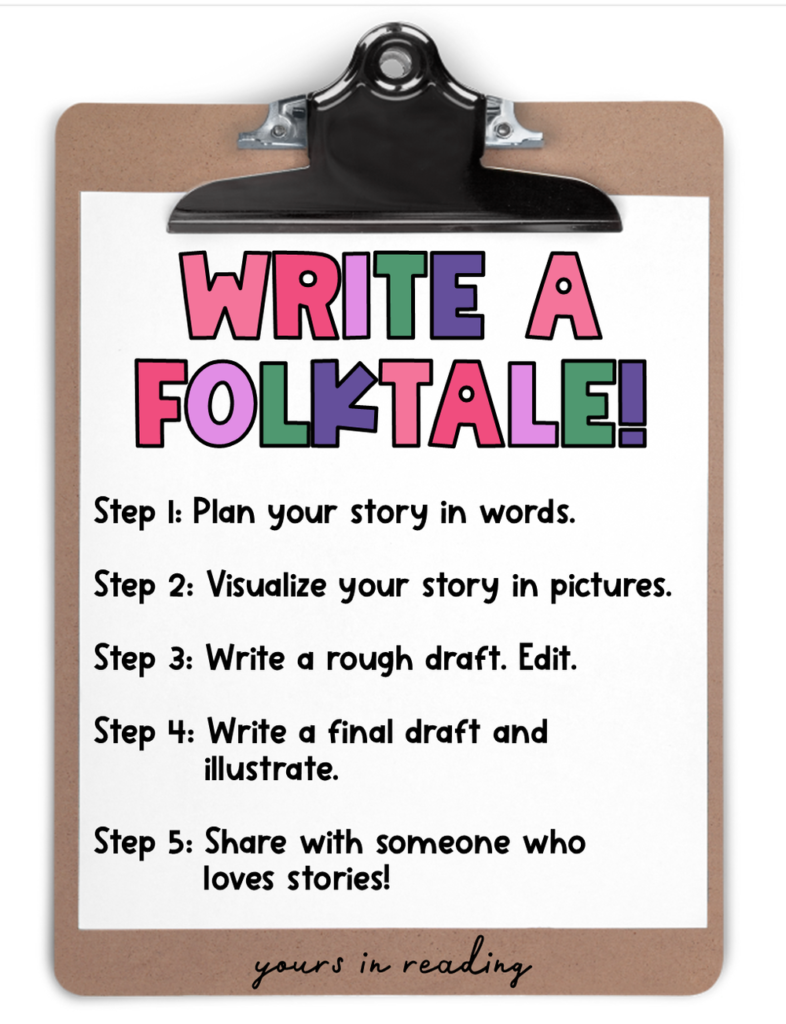
hello, freebie!
Grab your FREE Write a Folktale packet here!

